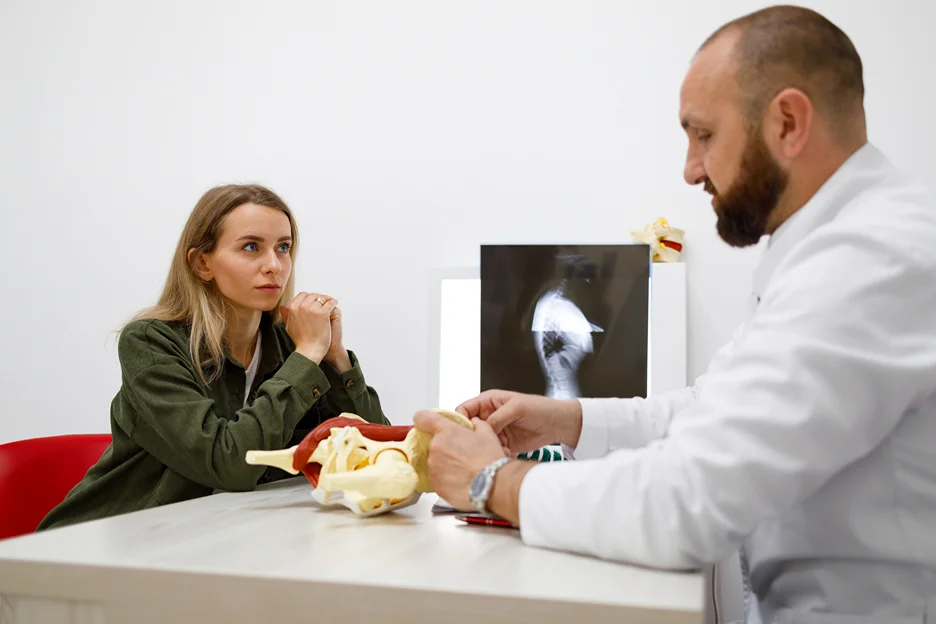Shooting, burning pain starting in your lower back and radiating down your leg? You may be suffering from sciatica. Up to 40% of people experience sciatica at some point, but getting the right diagnosis is key to finding relief.
This in-depth guide covers everything you need to know about sciatica diagnosis, from at-home tests to professional exams. Read on to learn what causes this agonizing nerve pain, how doctors evaluate and confirm sciatica, and when to seek emergency care. With the right insights, you can take control of sciatica and start feeling better fast.
What is Sciatica?
Sciatica refers to pain radiating along the path of the sciatic nerve, from the lower back through the hips and buttocks and down each leg. It often occurs when a herniated disk or bone overgrowth puts pressure on the sciatic nerve.
Is Sciatica the Same as Spinal Stenosis
Sciatica is a symptom of spinal stenosis, but not all individuals with spinal stenosis will suffer from sciatica. Spinal stenosis is a narrowing of the spaces within the spine that can put pressure on the nerves.
This narrowing is often caused by osteoarthritis and can result in sciatica symptoms. While sciatica describes the pain that is experienced, spinal stenosis is an underlying anatomical cause that can potentially bring on sciatica.
Is Sciatica the Same as a Slipped Disc
Slipped discs in the lower back region are the main cause of sciatica. It occurs when the cushion between two vertebrae (discs) slips out of place or ruptures. This puts pressure on the sciatic nerve.
Sciatica alone does not necessarily mean a slipped disc is present, as other issues like tight muscles or arthritis can also compress the nerve. A slipped disc is more of a structural problem that can put pressure on the sciatic nerve and cause sciatica pain.
Is Sciatica the Same as Piriformis Syndrome
If pain is only in the lower back and buttocks when moving the hips and legs, it may be piriformis syndrome where the piriformis muscle irritates the sciatic nerve. If pain radiates down the thigh and leg, it is likely sciatica caused by a compressed sciatic nerve from a herniated disc or spinal stenosis.
While both conditions can cause similar symptoms like pain in the back of the leg, they are caused by irritation or compression of the sciatic nerve in different parts of the body.
Is Sciatica the Same as Radiculopathy
While radiculopathy can occur anywhere along the spinal column, it most often affects the lumbar region. In lumbar radiculopathy, irritation of the nerve roots forming the sciatic nerve causes the signature radiating pain known as sciatica.
Radiculopathy causes symptoms like pain, numbness, tingling, and weakness in areas served by the affected nerve. For sciatica, it is the radiating pain from the lower back through the thigh and down the leg.
How to Diagnose Sciatica

Sciatica is typically diagnosed based on a patient’s medical history and symptoms. The most common tests for sciatica diagnosis are:
| Test | Description |
| Straight leg raise test | The doctor raises the patient’s leg while lying down to check for sciatic nerve pain and discomfort. Pain or difficulty raising the leg can indicate sciatica. |
| Slump test | Similar to the straight leg raise test, but the patient’s back is in a slumped position. This tests for sciatic nerve compression. |
| Imaging tests | X-rays, MRI, or CT scans may be used to check for spinal issues like herniated discs that could be pinching the sciatic nerve. Imaging is not always needed for diagnosis. |
| Physical exam | Doctors will feel along the back and legs to check for tender areas and look for signs of weakness, numbness, or tingling in the legs that could suggest sciatica. |
The goal of diagnosis is to determine if the patient’s symptoms are due to irritation or compression of the sciatic nerve and to rule out other potential causes. Treatment options can then be discussed based on the diagnosis.
How to Test for Sciatica at Home
In addition to medical tests like the straight leg raise and slump tests, which should be administered by a doctor, there are some simple tests you can try at home to check for possible signs of sciatica:
Nerve Stretch Test
The femoral nerve stretch test screens for leg dorsal soft tissue sensitivity possibly related to nerve root impingement. It detects spinal nerve compression associated with disc protrusion and femoral nerve injury. To do this:
- Sit on the floor with one leg extended straight out and the other leg bent inward, bringing your foot toward your body.
- Lean forward slightly over the straight leg and hold this stretched position for about 30 seconds.
If you experience any tingling, numbness or shooting pain down the back of your leg, it may indicate sciatic nerve irritation.
Walking Tests
Walking tests can be performed at home to help diagnose sciatica. Tests include:
- Walking on toes
- Walking on heels
- Walking normally
These are done to identify muscle weakness or nerve damage, and normally to observe gait for abnormalities.
How to Diagnose Sciatic Endometriosis
The gold standard for diagnosing sciatic endometriosis is histopathological examination of tissue. This involves microscopic study of tissue manifestations to confirm the final diagnosis. The examination plays a crucial role by providing definitive diagnosis of sciatic endometriosis.
This condition can also be diagnosed through:
- Conducting a physical exam such as the Lasègue’s test or straight leg raise test
- Magnetic resonance imaging (MRI) is helpful for diagnosis and surgical planning.
- Other imaging tests like ultrasound and CT scans can help supplement clinical findings
- Conducting a laparoscopic surgical exploration of the pelvic nerves to check for irritations, compressions, injuries or tumors that may be caused by endometriosis.
What is The Best Home Treatment for Sciatica
For the first 7 days, apply ice to painful areas for 10-15 minutes several times daily to reduce inflammation. After 1 week, alternate ice (10-15 mins) and heat (20 mins) to relieve sciatica nerve pain. Ice reduces inflammation, while heat promotes blood flow.
Other great ways to treat sciatica at home include:
- Stretching exercises like hamstring stretches and gluteal stretches to loosen tight muscles around the sciatic nerve.
- Massage therapy to ease pain and improve mobility by increasing blood flow.
- Over-the-counter pain relievers like ibuprofen and acetaminophen to reduce pain and inflammation.
After a few weeks, if home treatments do not provide relief, see a doctor. They may recommend other treatments such as physical therapy and injections.
How to Keep Sciatica from Coming Back
Once you have experienced an episode of sciatica, it is important to take steps to prevent it from coming back. Here are some tips:
- Do core and back strengthening exercises. Building up the muscles that support your lower spine can help take pressure off the sciatic nerve. Try bridges, planks, and other core moves.
- Maintain good posture. Slouching puts more strain on your back. Be mindful of sitting and standing tall.
- Stay active. Low-impact activities like walking, swimming, and yoga keep your back muscles strong without jarring your spine.
- Lift properly. Use your legs and avoid bending your back when lifting heavy objects. This prevents injury.
- Manage your weight. Extra weight adds more stress to your lower back. Losing weight if needed can relieve sciatica.
- Quit smoking. Smoking is linked to a higher risk of developing sciatica. Kicking the habit can help.
- Get enough sleep. Fatigue causes muscle tension which can aggravate back pain and sciatica.
- Try physical therapy. A PT can provide sciatica-specific exercises to help manage and prevent pain.
- See your doctor. If lifestyle changes don’t seem to be working, your doctor may recommend additional treatments.
The key is staying proactive with exercise and healthy habits. This will help keep sciatica at bay and prevent future flare ups.
Seeking Specialist Treatment

If you continue experiencing sciatica pain, consider seeing a specialist with advanced training in spine disorders, cutting-edge tools to accurately diagnose nerve compression,and provide personalized, effective treatment. Don’t suffer needlessly – find the best sciatica specialist near you by using Kaly!
The Bottom Line
While sciatica can be extremely painful, an accurate diagnosis guides the way to tailored treatments that can help eliminate nerve irritation. Don’t hesitate to see a doctor, especially if pain persists or worsens. Sign up for Kaly here.
